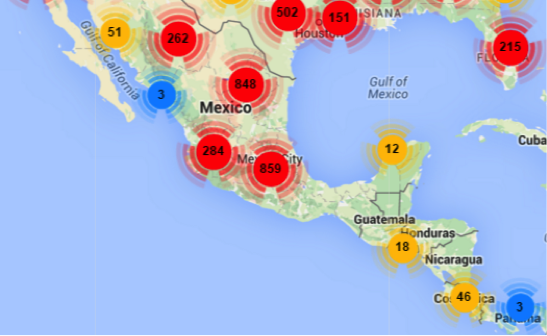 Hurricane Patricia – the strongest hurricane ever recorded in the western hemisphere – made landfall on the Pacific coast of Mexico on Friday, October 23rd, around 6:15 p.m. local time. The supply chain event impact, while still being assessed, clearly can be characterized as minor, especially when compared to relatively recent historic extreme weather events such as Hurricane’s Katrina and Sandy and other “acts of god’ such as the Japan Earthquake and Tsunami and the Thailand floods of 2011. It is nevertheless significant as it represents the first weather event with the potential to impact supply chains that can be definitively linked to the El Niño weather pattern.
Hurricane Patricia – the strongest hurricane ever recorded in the western hemisphere – made landfall on the Pacific coast of Mexico on Friday, October 23rd, around 6:15 p.m. local time. The supply chain event impact, while still being assessed, clearly can be characterized as minor, especially when compared to relatively recent historic extreme weather events such as Hurricane’s Katrina and Sandy and other “acts of god’ such as the Japan Earthquake and Tsunami and the Thailand floods of 2011. It is nevertheless significant as it represents the first weather event with the potential to impact supply chains that can be definitively linked to the El Niño weather pattern.
Several events running up to Patricia have been postulated to be linked to El Niño. These include Typhoon Soudelor (August), Hurricane Etau in Japan (September), Typhoon Dujuan in Taiwan and Eastern China (September), and even the air quality crisis in Singapore and Malaysia (September) caused by Indonesia forest fires associated with El Niño induced drought conditions. However, based on the consensus of scientists and climatologists (including those at NASA and Stanford University), the connection between Hurricane Patricia and El Niño is not in the realm of conjecture, but rather reality.
We have been warning our clients and the broader supply chain management professional community for months to take proactive mitigation actions in preparation for the impending El Niño. In a recent impact analysis white paper entitled El Niño: A Test of CPO Leadership and Your Supply Chain Resiliency Culture, we argued that El Niño is unique in that it is perhaps the only supply chain disruption phenomenon in which the general timing and geographic location of the potential impact is known well in advance, providing a unique opportunity to plan and prepare. It concludes that if executive leadership is blindsided by El Niño, they have no one else to blame but themselves.
The good news is that it’s not too late to get started. We are only in the first inning of a nine inning ball game. There is no more time to waste, but it is not too late to identify your areas of geographic exposure to El Nino driven extreme drought and precipitation conditions. The next step is to map suppliers, sites and parts at risk, and then proactively quantify and prioritize mitigation opportunities based on revenue-at-risk.
Although fears of a major catastrophe did not materialize, as there were no immediate reports of any deaths or damages to major infrastructure, the potential for supply chain impact from Hurricane Patricia for companies with significant supplier exposure in the western coast of Mexico (specifically the states of Nayarit, Colima, and Jalisco), was daunting. The Pacific coast of Mexico is home to numerous automotive, high tech, life sciences, and other industrial manufacturing facilities, as well as port and freight operations. Key companies in the region include Flextronics, America Movil, Mexichem, Grupo Mexico, Pacific Coast Energy and Minerals LLC, and Ciudad Industrial Morelia. But, in the end supply chain impact appears limited to minor work operation disruptions from localized wind damage, floods, and mudslides impeding workforce transportation and the flow of goods in-and-out of southwestern Mexico.
According to experts, the favorable outcome can be attributed to two factors: preparation and luck. As reported in the Sunday New York Times (“Mexico Exhales After Surviving A Giant Storm,” by Azam Ahmed and Paulina Villegas, October 15, 2015), the Mexican authorities learned some hard lessons from inadequate responses to earlier responses. Mexico now has a national emergency response system that coordinates with authorities at the local level. Federal and local officials were effective in proactively moving people out of harm’s way, and after the storm responded quickly to clear roadways and begin to restore power and communication lines. Despite the effective planning, the impact still had the potential for devastating if not for a lucky break. The path of the storm passed between two major cities, Puerto Vallarta and Manzanillo, but hit neither directly. It then quickly dissipated 12 hours after touching ground when it veered into a mountainous region.
The key take-away from the Hurricane Patria experience is that luck, or hope if you prefer, is not a strategy. Enterprises should follow the lead of the Mexican government and invest in proactive risk mitigation plans and post-event emergency response preparedness. Hurricane Patricia represents perhaps your final wake-up call. For those who prepare, global supply chain disruption events are viewed not as threats but as opportunities to gain competitive advantage.




